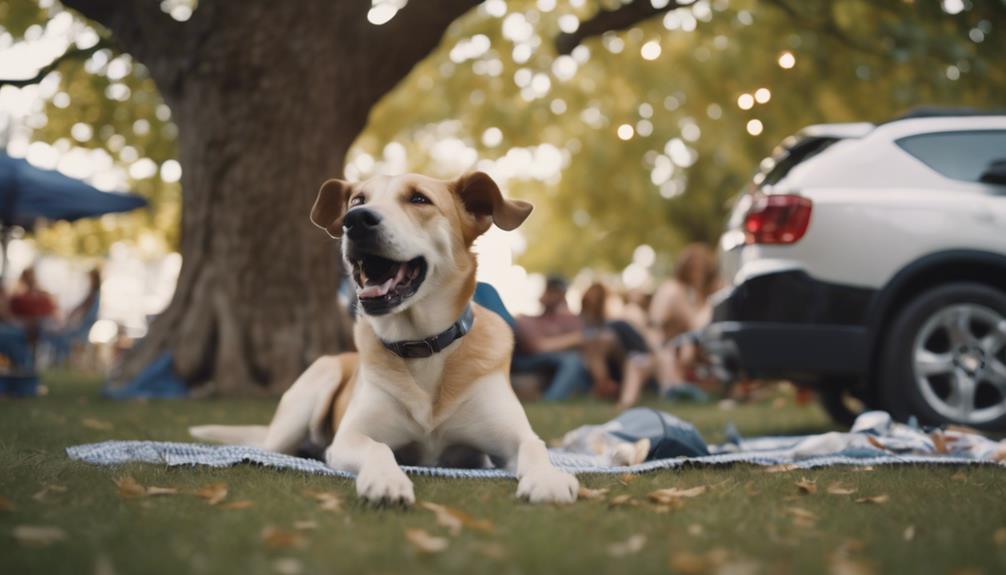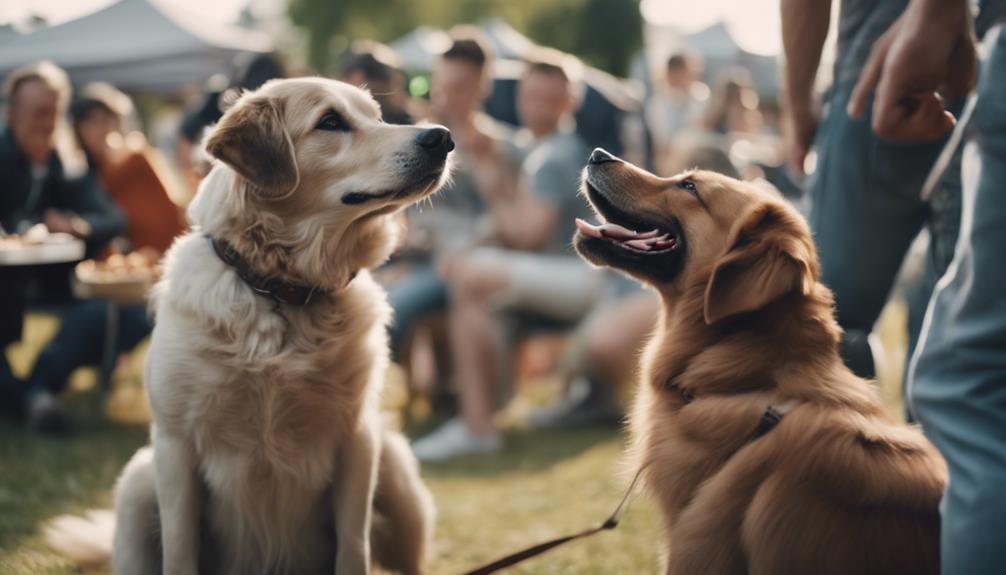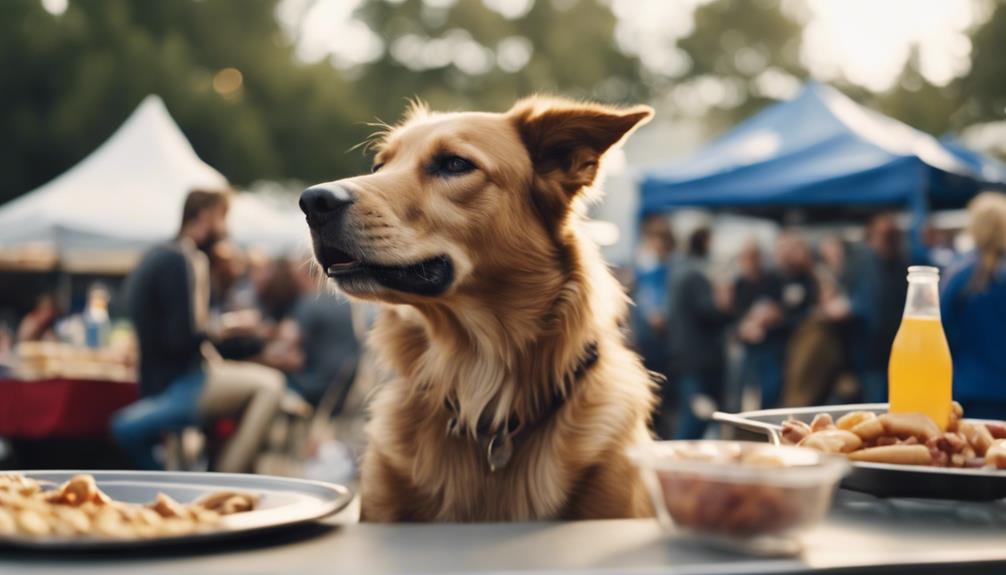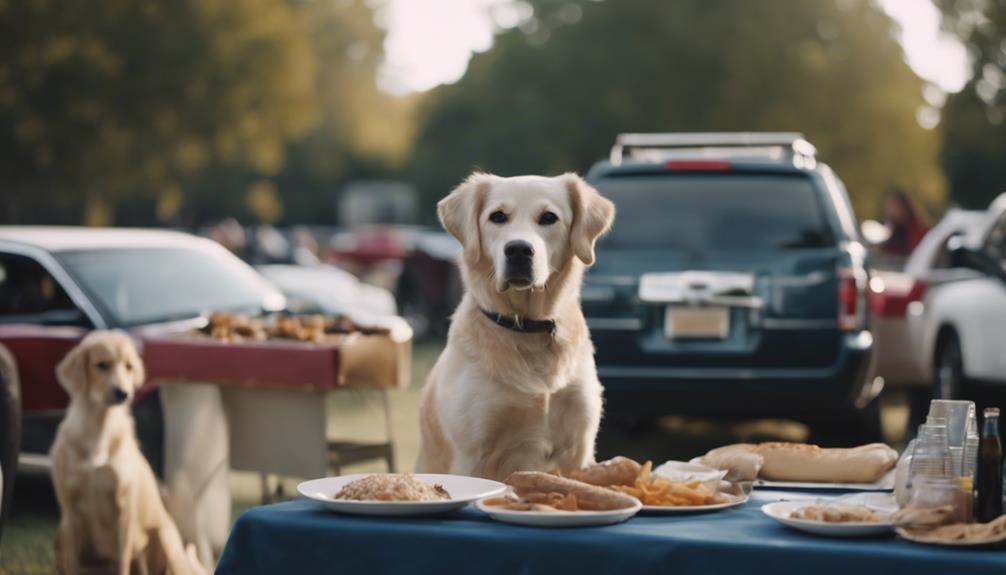Tailgating with your dog can be a delightful experience, but it requires a thoughtful approach to ensure a seamless integration of your furry companion into the festivities.
From understanding your dog's body language cues to steering clear of potential hazards like table scraps, there are numerous considerations to keep in mind for a successful tailgating outing.
By being attuned to your dog's needs and taking proactive steps to address them, you can set the stage for an enjoyable and stress-free time for both your pet and fellow tailgaters.
Key Takeaways
- Observe dog's body language for comfort and stress cues.
- Avoid feeding table scraps to prioritize dog's health.
- Introduce dog to strangers gradually for positive interactions.
- Prioritize dog's well-being and enjoyment in tailgate settings.
Evaluate Your Dog's Social Behavior
Assessing your dog's sociability is crucial before bringing them to a tailgate event. Some dogs thrive in social settings, while others may feel anxious or overwhelmed. Observe how your dog interacts with new people and other animals to gauge their comfort level. Look for signs of friendliness such as wagging tails, relaxed body language, and a willingness to approach others.
On the contrary, signs of discomfort may include cowering, growling, or trying to escape. Understanding your dog's social behavior will help you make an informed decision about whether they will enjoy a tailgate atmosphere. It is essential to prioritize your dog's well-being and ensure they will have a positive experience at the event.
Assess Your Party Enjoyment Preferences
Before bringing your dog to a tailgate event, it is essential to consider your own preferences for enjoyment at the party. Assess whether you prefer a more relaxed gathering or a lively, bustling atmosphere.
Tailgate parties can vary greatly in noise levels, crowd size, and overall excitement. Think about how your dog might fit into these different scenarios and whether you would be comfortable managing your pet in such environments.
If you enjoy socializing with other partygoers, make sure your dog is well-socialized and comfortable around strangers. On the other hand, if you prefer a quieter setting, consider if the tailgate event aligns with your relaxation needs while still allowing your dog to have a positive experience.
Consider Your Dog's Environmental Adaptability

When contemplating bringing your dog to a tailgate event, it is crucial to gauge how well your furry companion can adapt to the various environmental factors present. Consider your dog's comfort with loud noises, crowds, and different smells that are common in tailgating environments.
Some dogs may become anxious or overwhelmed in such settings, leading to stress or undesirable behaviors. Additionally, assess your dog's tolerance for varying temperatures and weather conditions, as tailgates can take place in a range of climates.
It's important to prioritize your dog's well-being and ensure they will be safe and content amidst the hustle and bustle of a tailgate gathering. By understanding your dog's environmental adaptability, you can make an informed decision about whether to bring them along.
Decide on Bringing a Dog Responsibly
In making the decision to bring a dog to a tailgate, it is essential to carefully consider the responsibilities associated with canine companionship in such social settings. Bringing a dog requires thoughtful planning and commitment to ensure the well-being of your pet and those around you. Here are some emotional pointers to help you decide on bringing a dog responsibly:
- Reflect on your dog's comfort and safety in a crowded environment
- Consider the impact of noise and commotion on your dog's well-being
- Evaluate your ability to provide necessary care and attention during the event
- Think about the potential stress or anxiety your dog may experience in a new setting
- Ensure you are ready to prioritize your dog's needs throughout the tailgating experience.
Ensure Your Dog's Comfort With Strangers

To ensure your dog's comfort with strangers at a tailgate, introduce them gradually to unfamiliar individuals in a controlled and positive manner. This can help reduce your dog's anxiety and build their confidence around new people. Here is a table with tips to assist in ensuring your dog's comfort with strangers:
| Tips for Ensuring Your Dog's Comfort With Strangers |
|---|
| Introduce strangers gradually and positively |
| Use treats or toys to create a positive association |
| Allow your dog to approach strangers at their own pace |
| Watch for signs of discomfort or stress in your dog |
Watch for Body Language Clues
Observing your dog's body language is crucial during a tailgate to ensure their comfort and well-being in the social environment. Paying attention to subtle cues can help you understand how your dog is feeling and whether they are enjoying the experience. Here are some key body language clues to watch for:
- Tail position: A wagging tail can indicate happiness, while a tucked tail may signal fear or discomfort.
- Ear placement: Forward-facing ears suggest alertness, while pinned-back ears could mean your dog is anxious.
- Eye movements: Dilated pupils or avoiding eye contact may indicate stress.
- Posture changes: Stiffening or cowering could show unease.
- Vocalizations: Whining or barking excessively may be signs of distress.
Observe Signs of Stress

During a tailgate, it is essential to be vigilant for signs of stress in your dog to ensure their well-being and comfort in the social setting. Dogs may exhibit various signs indicating stress, such as excessive panting, drooling, trembling, or attempting to hide.
Additionally, watch for behaviors like yawning, lip-licking, or avoiding eye contact, which can signal discomfort. Some dogs may display aggression or excessive barking when feeling stressed. It's crucial to pay attention to your dog's body language and behavior to address any stress promptly.
Notice Changes in Behavior
When observing your dog during a tailgate, it is crucial to pay close attention to any changes in their behavior as it may indicate their comfort level in the social environment. Dogs communicate through their actions, and being attuned to these cues can help you ensure your furry friend is enjoying the experience. Here are some emotional responses to look out for:
- Increased wagging of the tail
- Relaxed body posture
- Playful behavior with other dogs
- Seeking interaction with humans
- Vocalizing happily in response to stimuli
Look for Signs of Emotional Distress

As you monitor your dog's behavior at a tailgate, be attentive to any indications of emotional distress that may manifest in their responses to the social setting. Signs of emotional distress in dogs can include panting, lip-licking, trembling, whining, or attempting to hide. These behaviors may suggest that your dog is feeling anxious, uncomfortable, or overwhelmed by the environment.
Additionally, pay attention to any changes in your dog's body language, such as flattened ears, a tucked tail, or avoiding eye contact. It's crucial to recognize these signs early on to prevent further stress or potential negative reactions. By being observant and responsive to your dog's emotional cues, you can ensure a safer and more enjoyable tailgating experience for both you and your furry companion.
Take Action if Discomfort Is Noticed
Vigilantly monitoring your dog's behavior and promptly addressing any signs of discomfort is essential for ensuring a positive and safe tailgating experience for both you and your canine companion. When discomfort is noticed, take action by:
- Calmly removing your dog from the stressful situation
- Providing a quiet and safe space for your dog to relax
- Offering comforting words and gentle pets to help soothe your dog
- Monitoring your dog closely for any improvements or worsening of symptoms
- Seeking professional help if your dog continues to display signs of distress
Conclusion
In conclusion, tailgating with your dog requires careful consideration of their behavior, preferences, and well-being.
By being attuned to subtle cues, observing signs of stress or discomfort, and taking proactive measures to ensure their comfort and safety, you can create a harmonious environment for both your furry friend and fellow tailgaters.
Prioritizing your dog's needs and making informed decisions will ultimately lead to a positive and enjoyable experience for all involved.




